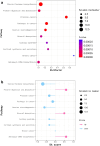Refined metabolite profiling in the collateral circulation of chronic total occlusion of coronary arteries: Insights from a metabolomics investigation
- PMID: 38414557
- PMCID: PMC10897845
- DOI: 10.1016/j.athplu.2024.02.001
Refined metabolite profiling in the collateral circulation of chronic total occlusion of coronary arteries: Insights from a metabolomics investigation
Abstract
Background and aims: To investigate the disparities in coronary collateral circulation (CCC) and peripheral serum metabolites among patients presenting with chronic total occlusion (CTO) of the coronary arteries, a non-targeted metabolic approach was employed.
Methods: A cohort of 22 patients diagnosed with CTO of coronary arteries in the context of coronary heart disease (CHD) was selected for blood sample collection from CCC and peripheral arteries. The patients were categorized into two groups, namely CTO-C and CTO-P. The Waters UPLC I-Class Plus is combined with the Q Exactive high-resolution mass spectrometer for metabolite separation and detection. The acquired raw data from mass spectrometry is subsequently imported into Compound Discoverer 3.2 software for comprehensive analysis, which seamlessly integrates the BGI Metabolome Database (BMDB), mzCloud database, and ChemSpider online database. Subsequently, the identified differential metabolites were subjected to a metabolic pathway enrichment analysis, as documented in the Kyoto Encyclopedia of Genes and Genomes (KEGG) database.
Results: A total of 403 differential metabolites were identified in CCC and peripheral serum samples from patients with CTO of coronary arteries in CHD. Compared to the CTO-P group, the CTO-C group exhibited decreased levels of metabolites such as Testosterone, dehydroepiandrosterone (DHA), deoxyacetone, while demonstrating increased levels of metabolites including Progesterone, androstanone, l-threonine. The biosynthesis pathway of steroid hormones emerges as the key metabolic pathway significantly associated with differential metabolites.
Conclusions: Through metabolomics analysis, distinct differences in the CCC and peripheral serum metabolites have been identified among patients with CTO of coronary artery. Notably, a significant association between the steroid hormone biosynthesis pathway and CCC has been observed.
Keywords: Collateral circulation; Coronary heart disease; Differential metabolites; Metabolic pathway; Non-targeted metabolomics.
© 2024 The Authors.
Conflict of interest statement
The authors declare that they have no known competing financial interests or personal relationships that could have appeared to influence the work reported in this paper.
Figures










Similar articles
-
[Correlation between insulin resistance and coronary collateral circulation in patients with chronic total coronary occlusion].Nan Fang Yi Ke Da Xue Xue Bao. 2024 Apr 20;44(4):780-786. doi: 10.12122/j.issn.1673-4254.2024.04.21. Nan Fang Yi Ke Da Xue Xue Bao. 2024. PMID: 38708513 Free PMC article. Chinese.
-
25-Hydroxy-vitamin D level may predict presence of coronary collaterals in patients with chronic coronary total occlusion.Postepy Kardiol Interwencyjnej. 2015;11(3):191-6. doi: 10.5114/pwki.2015.54012. Epub 2015 Sep 28. Postepy Kardiol Interwencyjnej. 2015. PMID: 26677358 Free PMC article.
-
Good coronary collateral circulation is not associated with better prognosis in patients with chronic total occlusion, regardless of treatment strategy.Hellenic J Cardiol. 2023 Jan-Feb;69:9-15. doi: 10.1016/j.hjc.2022.12.001. Epub 2022 Dec 9. Hellenic J Cardiol. 2023. PMID: 36509330
-
The relation of serum γ-glutamyl transferase levels and coronary collateral circulation in patients with chronic coronary total occlusion.Coron Artery Dis. 2013 Jun;24(4):298-302. doi: 10.1097/MCA.0b013e32835f301d. Coron Artery Dis. 2013. PMID: 23425773
-
The interactions and biological pathways among metabolomics products of patients with coronary heart disease.Biomed Pharmacother. 2024 Apr;173:116305. doi: 10.1016/j.biopha.2024.116305. Epub 2024 Feb 29. Biomed Pharmacother. 2024. PMID: 38422653 Review.
Cited by
-
Repurposing methimazole to promote coronary collateral circulation through MAPK1-mediated macrophage polarization via ferroptosis.Theranostics. 2025 Jun 9;15(14):6686-6701. doi: 10.7150/thno.111606. eCollection 2025. Theranostics. 2025. PMID: 40585971 Free PMC article.
-
Comparative transcriptome and metabolome analysis of sweet potato (Ipomoea batatas (L.) Lam.) tuber development.Front Plant Sci. 2025 Jan 7;15:1511602. doi: 10.3389/fpls.2024.1511602. eCollection 2024. Front Plant Sci. 2025. PMID: 39840368 Free PMC article.
-
[Correlation between insulin resistance and coronary collateral circulation in patients with chronic total coronary occlusion].Nan Fang Yi Ke Da Xue Xue Bao. 2024 Apr 20;44(4):780-786. doi: 10.12122/j.issn.1673-4254.2024.04.21. Nan Fang Yi Ke Da Xue Xue Bao. 2024. PMID: 38708513 Free PMC article. Chinese.
-
Is skimmed milk really heart-healthy?: A mediation Mendelian randomization analysis of coronary risk via serum metabolites.Medicine (Baltimore). 2025 Aug 22;104(34):e42653. doi: 10.1097/MD.0000000000042653. Medicine (Baltimore). 2025. PMID: 40859556 Free PMC article.
References
-
- Fearon W.F., Zimmermann F.M., De Bruyne B., Piroth Z., van Straten A., Szekely L., Davidavicius G., Kalinauskas G., Mansour S., Kharbanda R., Ostlund-Papadogeorgos N., Aminian A., Oldroyd K.G., Al-Attar N., Jagic N., Dambrink J.E., Kala P., Angeras O., MacCarthy P., Wendler O., Casselman F., Witt N., Mavromatis K., Miner S., Sarma J., Engstrom T., Christiansen E.H., Tonino P., Reardon M.J., Lu D., Ding V.Y., Kobayashi Y., Hlatky M.A., Mahaffey K.W., Desai M., Woo Y.J., Yeung A.C., Pijls N. Fractional flow reserve-guided PCI as compared with coronary bypass surgery. N Engl J Med. 2022;386:128–137. - PubMed
-
- Scala A., Erriquez A., Verardi F.M., Marrone A., Scollo E., Trichilo M., Durante A., Tedeschi D., Cortese B., Ielasi A., Valentini G., Tebaldi M., Campo G., Pavasini R., Biscaglia S. Functional (Re)development of SYNTAX score II 2020: predictive performance and risk assessment. J Clin Med. 2023;12 - PMC - PubMed
-
- Jang W.J., Yang J.H., Choi S.H., Song Y.B., Hahn J.Y., Choi J.H., Kim W.S., Lee Y.T., Gwon H.C. Long-term survival benefit of revascularization compared with medical therapy in patients with coronary chronic total occlusion and well-developed collateral circulation. JACC Cardiovasc Interv. 2015;8:271–279. - PubMed
-
- Kucukseymen S., Iannaccone M., Grantham J.A., Sapontis J., Juricic S., Ciardetti N., Mattesini A., Stojkovic S., Strauss B.H., Wijeysundera H.C., Werner G.S., D'Ascenzo F., Di Mario C. Association of successful percutaneous revascularization of chronic total occlusions with quality of life: a systematic review and meta-analysis. JAMA Netw Open. 2023;6 - PMC - PubMed
LinkOut - more resources
Full Text Sources
